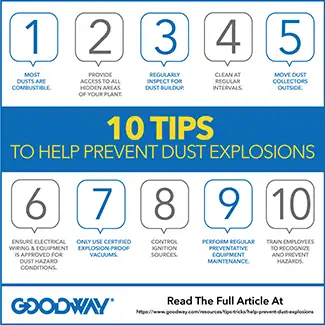As National Safety Month concludes at the end of June, Stamford, Connecticut-based Goodway Technologies reminds facility managers of the importance of understanding explosion and fire risks in the work environment. The combustive power of airborne particles, such as dust, is astounding and can be a threat to a number of different industries.
“Understanding how to identify and prevent risks in your production environment is critical for any plant manager or maintenance personnel,” said Frank Intrieri, vice president at Goodway Technologies. “A combustible dust explosion can be extremely devastating, which is why it’s important to take the proper steps to reduce potential hazards and concerns.”
Goodway Technologies has outlined 10 easy tips on how to help prevent dust explosions:
- Most dusts are combustible. According to the Occupational Safety and Health Administration (OSHA), any solid that can catch fire can become explosive when turned into dust.
- Provide access to all hidden areas of a plant or facility. Make sure that every horizontal surface in a plant can be accessed, including ductwork, beam and joist surfaces, and the area above suspended ceilings in order to assess dust buildup.
- Regularly inspect for dust. OSHA inspectors look for accumulations of 1/32 of an inch, which is about the thickness of a standard paper clip. Immediate cleaning is necessary when a layer of that amount covers a surface area equal to 5% of the floor area.
- Clean at regular intervals. Put a plan in place to conduct timely cleaning. Work cycle dust should be removed concurrently with operations and not be allowed to accumulate. Be mindful of dust dispersion during housekeeping.
- Move dust collectors outside. Dust collectors with a volume of greater that 8 cubic feet should be located on the exterior of a building to limit risks.
- Ensure electrical wiring and equipment is approved for dust hazard conditions. OSHA also recommends “The use of proper electrical equipment in hazardous locations is crucial to eliminating a common ignition source.”
- Only use certified industrial vacuums for explosive material pickup. Essential in hazardous dust environments, “explosion proof vacuums” approved for Class II conditions don’t produce sparks.
- Control ignition sources. Post “No Smoking” signs. Control static electricity by bonding and grounding equipment. Provide personal protective equipment, as needed, not only as a protective barrier for the employees, but also to prevent the ignition from static electricity.
- Perform regular preventative maintenance on equipment. Equipment in bad repair is a common cause of ignition.
- Train employees to recognize and prevent hazards. Proactively train new employees before they start work and again periodically, to refresh material, or when they are reassigned. In addition to understanding safe work practices relating to their tasks, employees should also know the overall plant programs for dust control and ignition source control. Develop a company culture of safety by encouraging employees to report unsafe practices. If fine dust, powders, or other flammables are used in the facility, think about using these tips and to start your preparedness.
“There are a variety of options when it comes to industrial vacuums and it is also important to make sure you are using the appropriate equipment for the application and materials that are being picked up,” said Intrieri. “Goodway Technologies offers a selection of industrial vacuum cleaners for different applications and needs, which are outlined in our Industrial “Explosion Proof” Vacuum Buying Guide. Our team of experts can also help determine which is the best solution that meets the necessary classifications required for your plant.”
A hazardous, or classified, location is defined by the National Electrical Code (NEC) as a working area with a risk of explosion or fire due to the presence of flammable gases, vapors, dust, or ignitable fibers in the air. Electrical sparks, arcs or hot surfaces may cause gases and other airborne particles to ignite, resulting in injury, loss of life and property damage.
The NEC uses a class/division/group system to identify the different risk levels.
- Class defines the kind of hazardous material present in the area.
- Division defines the likelihood that a hazardous material may be present in sufficient quantities to ignite or explode.
- Group more clearly defines the specific type of hazard in the atmosphere.
Goodway Technologies further breaks down the classifications in their buying guide which can help you to understand an area’s explosion and fire risk. In addition to knowing the potential risks and hazards in a facility, it is also important to have the correct maintenance tools, especially when purchasing industrial vacuum cleaners to clean or pick up hazardous materials.
While this information can be used as a reference, plant and facility managers need to discuss best practices with their safety officer or maintenance personnel before selecting equipment. NEC Article 500 also will provide information on how to choose the correct enclosures to keep people and property safe.
For more information, visit www.goodway.com.





